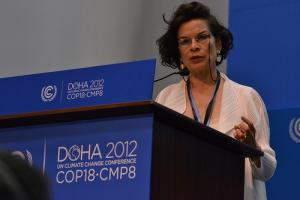by Cecilia Schubert
A discussion on the restoration of degraded lands would not rivet most people. That is, not until they realise that without good land, farming becomes impossible, and without farming, there is no food.
At a side event organised by the The International Union for Conservation of Nature (IUCN) alongside the UN Climate Talks in Doha, experts and ambassadors spoke passionately on the need to restore degraded land, to safeguard the future of farmers, indige
nous people, forest communities, small villages, pastoralists, and others who depend on the food they produce.
 One of the session's expert panelists, Pak Kuntoro from Indonesia, was so engrossed in the topic that he sat with his back to the audience, intensively following the other presenter’s slides on the big screen.
One of the session's expert panelists, Pak Kuntoro from Indonesia, was so engrossed in the topic that he sat with his back to the audience, intensively following the other presenter’s slides on the big screen.
The topic goes hand in hand with the themes ofAgriculture, Landscapes and Livelihoods Day (ALL5) held earlier this week: how to transform rural landscapes to be more food secure in a changing climate, using holistic, sustainable approaches.
The event got off to a great start with an inspiring speech by Bianca Jagger,goodwill ambassador for “Plant a Pledge” – an online campaign to mobilize public support for a major land restoration initiative led by the IUCN, andspeaker at Forest Day a few days earlier.
“This has been the era of procrastination” she said to a full-packed room, “and now we see the consequences.”
Restoring areas that have been degraded is one way to improve our gloomy future predictions. At the moment, countries have pledged millions of hectares to the campaign Plant a Pledge, which aims to restore 150 million hectares of forest and degraded land by 2020. This is equivalent to 15 per cent of the estimated area of degraded forests worldwide.
Proof from the field
There are thus many activities going on at the moment, but one example where results are already visibleoundn China. Launched in 1999, the Grain for Green Programme restoration project focused on the Loess Plateau area in China, where there was a degraded area covering 624,000 km2 of which over 60 per cent faced severe erosion. Between 2000 and 2008, the area of land use conversion had already amounted to 2 million ha and benefitted 2.5 million households.
Read more about this and other successful case studies on Climate Smart Agriculture presented during the conference.
Restored land can be put into use for agriculture to improve yields, regenerate forests and vegetation, agroforestry systems, and lake side planting to protect people from storms and much more. There is thus a lot to win for plenty of stakeholders from restoring abused and mismanaged lands.
“You will fail if you fail to have the local community’s support”
A restored landscape will only stay like that however, if the community is involved. They need to be engaged in the activities and alternative livelihood-activities should be presented. Otherwise trees might be cut down again in an unsustainable matter.
This was also something on Pak Kuntoro’s mind when he showed a picture of indigenous Indonesian tribes living in and by the tropical forest. “You fail if you fail to have the local community supporting your program” he said repeatedly, because at the end of the day, “it is they who protect the forest and they could care less about carbon”. “They don’t even know what carbon is,” he shouted passionately.
"We can sit and put a price on carbon, while people are managing, and caring for our remaining forests around the world, because they depend on it and value its benefits. We should be supporting them instead," he said.
But restoring lands under a landscape approach will come with trade-offs. There will be decisions on where to expand agriculture, in order to meet future food demands, and which parts of the surrounding forest should be restored.As agriculture is the leading cause of some 75 per cent of global deforestation,it is important that the two sectors work together when planning for a sustainable landscape that benefits rural communities.
Original Article Here


No comments:
Post a Comment